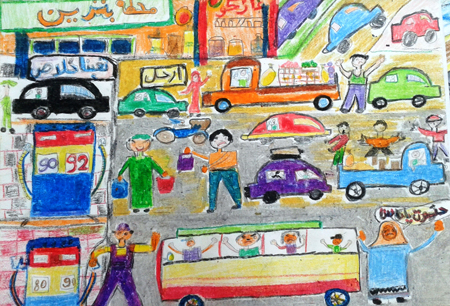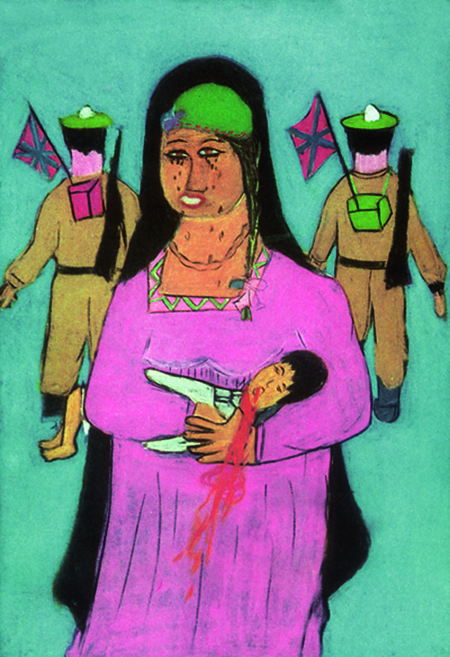"Whatever they do to oppress you and kill you we are reborn for you. You're not a port or a city, you are our soul, Port Said." Painted by 10-year old Roba Sharaby from Port Said, these words appear among a sea of protestors, their tears running and clothes colourful.
Currently exhibited at Darb 1718 is the outcome of an art workshop held earlier this year in Port Said in which the city’s children were invited to chronicle their experiences since the revolution broke out in 2011. The paintings are accompanied by images created by children in 1957 in a similar workshop also held in another tumultuous period for the city.
The artwork resulting from the 2013 exhibition depicts layers of pain and melancholy: wounded protestors, poignant chants, teargas and specks of blood make their way into the collection of paintings showcased in Darb 1781's Cairo art space. But the collection is not devoid of hope; palpable throughout the exhibition is a sense of affection and attachment to Port Said.

Painting from the 2013 workshop in Port Said. (Photo: courtesy of RAWI)
The mounting instability following 2011 echoed in the city of Port Said, but never as vehemently as after the notorious "football massacre" that took place early February 2012. The incident, where the Port Said based football team Al-Masry's fans assaulted Cairene fans of the rival Ahly football club, resulted in 72 deaths of the latter and left the city stumbling under an unofficial economic and social boycott. Violence in the wake of the football tragedy, particularly after 21 of the city's residents received death sentences, took its toll on Port Said. With fewer tourists and strict security mandates, including a state-imposed curfew, the city's commercial district ailed and a sense of isolation pervaded.
Displacement and death are not foreign notions to the city's residents. After the 1956 Suez War with France, England and Israel following President Gamal Abdel Nasser's nationalisation of the Suez Canal Company, Port Said witnessed the Six Day War with Israel in 1967, the War of Attrition with Israel from 1967 to 1973, and the October 1973 Arab-Israeli war.
The workshop held this spring at Port Said’s Gana Gallery mimics an art workshop held by Mohamed Labib and Seddika Hassanein in the wake of the 1956 Tripartite Aggression. The couple intended for the workshop to help the children navigate the woes of war and bloodshed. And this year, the pair’s son, Tarek Labib, teamed up with RAWI Magazine’s Yasmine El-Dorghamy to recreate the workshop. In both workshops the resulting work emerged as an honest and harrowing reflection of events in Port Said, told through the eyes of its children.
Researching an article about architect Tarek Labib last year, El-Dorghamy stumbled upon pictures of the 1957 workshop drawings at his home. She was struck by how morbid and violent the artworks were, even more so because they were painted by children. Labib was equally struck by the images the first time he came across the remnants of the workshop a few years ago, while flipping through piles of worn-out black and white photographs and miscellaneous keepsakes with his mother, Seddika Hassanein.
“Reminiscing about the past with my mum, seven or eight years ago, I was intrigued by a strange brochure with drawings by kids, and that was when she first told me the story,” recalls Labib.
Towards the end of 1956, his parents, who were at the time studying in Spain, came back to Egypt bearing art supplies and an idea to use art as therapy for a group of kids in the war torn Port Said. Combining fine arts with psychology was rather avant-garde of the couple, Labib remembers fondly.
The workshop, held for two weeks in 1957, yielded heart-wrenching artwork by children aged eight to 14, that was ultimately exhibited across Europe. The paintings were last seen at the Egyptian Academy of Arts in Rome, their whereabouts unknown today.

Painting from the 1957 workshop in Port Said. (Photo: courtsy of Rawi)
Unable to overlook the symmetrical suffering of Port Said’s children in today’s Egypt, Labib and El-Dorghamy set out to recreate the experience in the city.
“I thought, since Port Said is experiencing a similar kind of upheaval, why not revive the workshop?” said Labib.
Held at Gallery Gana, a low-budget art space in Port Said, the art classes invited children to freely express their outlooks on the events that enveloped their lives over the past few years.
“We asked them to draw their lives in recent years,” El-Dorghamy said. “This was a call for the children to express themselves; to acknowledge what has happened, and get it out.”
A group of ordinary teenagers from Port Said were therefore led to wrack their brains to create visual autobiographies, an experience that was both therapeutic and challenging.
Hanging on four large coloured cubes at Darb 1718 is the outcome from the 2013 workshop; artworks painted in pencil colours, oil pastels and watercolours that chronicle the recent history of Port Said through the eyes of its children.
A painting shows a figure in a dark mask, its bloodied hands hauntingly clutching a football. The piece by Shaimaa Lebeleb reflects the tragic events of the football massacre in 2012.
One of the strongest paintings is by Amal El-Fokeiri, who creates an action-packed scene in mixed media filled to the brim with detail. Amid clouds of tear gas blotched with bloodstains, protestors cough and stand with indignant looks on their faces. A coffin covered in Egypt’s flag can be spotted at the back.
Art outside the capital
“Port Said doesn’t see enough art and culture, so this was a monumental event,” said El- Dorghamy. Compared to Cairo, where there are dozens of art galleries and cultural events, some of Egypt’s other governorates suffer a dearth in cultural venues and activities.
“There is so much eagerness to consume culture in other governorates, but there’s a terrible centralisation of culture in Egypt,” El-Dorghamy says. “There is a need for stronger support for art outside the capital.”
El-Dorghamy said she is very passionate about establishing cultural venues for the ordinary people in governorates outside Cairo.
The Children of Port Said is very plainly curated, perhaps reflecting the relative modesty of the young art scene of Port Said and the raw, honest expressions of these workshop participants.
In a way, this exhibition says: Art does not need to be wrapped in fancy paper to be significant or to demand attention.
Programme:
The Children of Port Said runs until Thursday, 21 November
Darb 1718,
Qasr Al-Shamee Street, Al-Fakhareen – Old Cairo
(Behind the Hanging Church and Amr Ibn Al-As Mosque)
Short link: